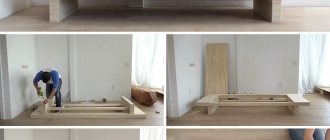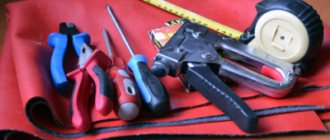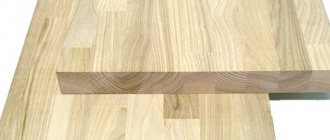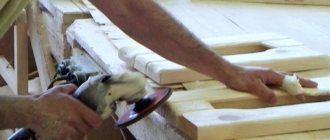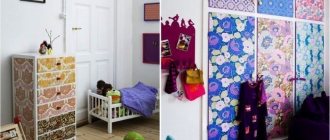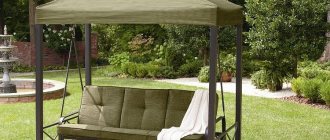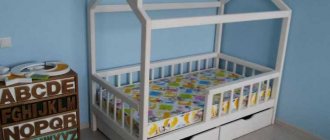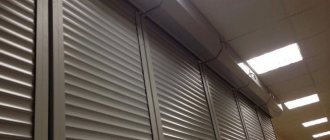0
9681
Wicker furniture is considered an excellent solution for different interiors and exteriors. It has many advantages and is presented in numerous forms; you can create wicker furniture with your own hands quickly and easily, and at the same time it can fully meet the needs of direct users. The whole process is divided into simple sequential steps, so if you first make a drawing, watch a training video and follow the instructions exactly, you will get a reliable and durable design.
Benefits of wicker furniture in the home
Weaving furniture from willow with your own hands has its advantages over the classic option of creating it from wood or chipboard. In addition to classic wicker, you can use other natural materials, such as rattan, reeds and even waste newspapers.
Furniture can be made from different natural materials.
- A chair or sofa made of wicker has a low cost compared to other materials.
- You will have a unique headset that no one else has.
- You will make furniture according to individual measurements depending on the size of the room. You no longer need to think about how to place an oversized set. You can weave it to the desired size and shape.
- The products are light, although they can withstand the weight of an adult. This is a comfortable solution for creating a children's set or furniture for the elderly.
- The process of making a product from wicker is not difficult if you understand the technology and watch several training videos.
- Natural weaving material is hypoallergenic and has no specific odors of paint or varnish. This is suitable for people prone to allergic reactions.
- The furniture is easy to clean. The only factors that a wicker product does not tolerate are regular exposure to ultraviolet rays and exposure to rain. But he also doesn’t like excessive dryness. Therefore, it is not recommended to leave it in bad weather or under the scorching sun for a long time. But once a month, cover the wicker product with a wet towel to prevent the material from drying out and cracking.
- This headset has a very long service life. If you treat it with care, it will last for decades.
Wicker furniture has many advantages.
Step-by-step master class on weaving for beginners
The general algorithm of actions is simple: you need to decide what the structure will be made of and what the braid will be supported on. There are more than enough step-by-step instructions on how to make wicker furniture. Most of them have been tested by many craftsmen in practice and found to be effective.
Artificial rattan stool
For work you will need: a wooden beam, tools and materials for processing it, self-tapping screws, strong non-stretchable tape, a furniture stapler, polyrattan, a knife. During assembly and weaving, a simple pattern of actions is followed. Step-by-step master class:
- A stable frame with additional rigidity bars is made from timber. All elements are connected with self-tapping screws, the structure is impregnated with an antiseptic.
- The seat is reinforced with tapes attached to the beam with furniture staples and screws. If you have experience, you can weave beautiful braids or strands from poly rattan for these purposes.
- The rattan is cut into short and long strips, laid tightly in a 2:1 alternation ratio and secured with staples.
- Ribbons are prepared for continuous transverse weaving of a different shade. The blanks are woven with the pattern shifted by 1 strip.
- The ends are finally fixed on the back side of the beam and trimmed.
- The sidewalls are weaved from longer strips (up to 5–7 m, depending on the experience of the craftsman).
- Two vertical strips of artificial rattan are fixed and hidden on the legs.
If desired, the legs can be braided in a circle with a single-color material.
Chair made of wicker
Do-it-yourself weaving of willow furniture begins with the preparation of raw materials and frame; work is carried out in stages:
- The rods are soaked in hot water for at least a day and dried.
- A rectangular frame of a chair seat is knocked together from 4 even pieces of wood; 4 support legs are attached in front and behind with self-tapping screws (taking into account the need for armrests or without them).
- The assembled structure is reinforced from below with 4 horizontal stiffeners (legs). The upper arch of the back is secured after weaving it, last.
- Vertical risers are attached to the back of the frame.
- The seat, side elements, lower part (if available), and back are woven in sequence, with the obligatory sealing of each row. To simplify the work, the product is turned over. The last to be braided are the legs.
- The joints with the edges are additionally braided with flexible willow twigs.
- The stability of the structure is checked and minor defects are eliminated.
Types of antique furniture, tips for arranging it
Using this algorithm, both ordinary chairs with a back and volumetric chairs are woven; the difference is manifested in the shape of the furniture frame and the presence of armrests. If there is no weaving in the lower part or openwork weaving is performed, the requirements for the stability of furniture legs become more stringent.
Coffee table made from newspaper tubes
To obtain a round table with a double tabletop, in addition to newsprint, you will need durable three-layer cardboard. You also need to prepare moisture-resistant wallpaper to match the future color, 4 round hollow cardboard or aluminum tubes, knitting needles No. 1.8–2, a screwdriver, Titan glue, a universal primer, stain and acrylic varnish. The work is carried out in the following sequence:
- Using knitting needles and a screwdriver, thick paper blanks are made.
- In a plastic container, prepare a solution of stain (1 l), acrylic varnish and primer (1 tablespoon each) for soaking the tubes for 5–20 minutes (the color of the blanks may vary).
- The painted rods are dried for 3–12 hours (depending on the humidity level or time of year), and placed in a bag.
- The upper tabletop of the table is prepared: two circles of the same diameter are cut out of cardboard, the upper part is braided in a circle (the weaving pattern is a rope), 4 round holes are cut out in the lower part to secure the legs. The bottom edge with the area in the center is covered with wallpaper.
- Round furniture supports are braided with paper rods (1 cm at the top remains open), all finished elements are connected and glued.
- A round inner shelf is made from the tubes, secured to the crosspiece with an awl.
- The legs are decorated with inserts of a different color (optional).
In order for a wicker table to last as long as possible, it must be varnished.
Selection and preparation of raw materials
It is necessary to prepare raw materials until visible buds form on the branches. Using a sharp knife at a 40-degree angle, trim branches with a thin core. Bend each rod and test it for flexibility. If the branch does not break, but bends well, it is suitable for creating furniture from the vine with your own hands.
The material must be prepared before the buds appear.
If you plan to weave from willow branches, they can be harvested in the fall. Make sure that there are no buds on the rods yet or that they have already outlived their useful life. The surface of the raw material must be smooth, without knots. If you take natural material with buds, they can begin to germinate while already in the product.
Vine
Willow vine has good flexibility and wear resistance. This is a budget material that is suitable for beginners. The vine must be harvested on time, in early spring or autumn, so that its branches do not become coarse. Disadvantages include a tendency to dry out and crack. Therefore, it is not advisable to keep products made from wicker for a long time in the rain or scorching sun.
The vine is flexible and suitable for beginners.
Rattan
Comfortable weaving material, resistant to moisture. Rattan looks impressive both in interior items and in finished furniture. It is lightweight, flexible, and comfortable to use. This is an inexpensive option for beginners who decide to start making furniture from natural materials.
Rattan tolerates moisture well and is convenient for weaving.
Newspaper tubes
A budget option for city residents, when the “vine” can be made independently, literally from improvised means. You don’t need to go to the forest to harvest, because you can twist the tubes yourself. Of course, this will require a lot of newspapers, PVA glue, patience, perseverance and free time.
Furniture can even be woven from newspapers.
But you can make a luxurious furniture set from ordinary newspaper. Any paper product is suitable as a material: cardboard, newspapers, covered notebooks, notepads and magazines.
Reed
Reeds are often used to make DIY wicker furniture. This material is especially often used to create cozy armchairs. This is one of the most ancient weaving methods that has survived to this day. To work, take a part of the stem that is under water after the leaves turn yellow. This usually happens in early autumn. In addition to reeds, stems and leaves of cattail and reed are also used for weaving.
You can make beautiful and comfortable chairs from reed stems.
Bamboo
Bamboo is suitable for those who have already woven more than one chair or sofa. This is a tough vine that requires care and experience in handling. But if you managed to conquer bamboo fiber, you are a true weaving master!
Bamboo is the most difficult type of furniture to weave.
Advantages and disadvantages
The advantages of creating wicker furniture include:
- low costs for obtaining unique designs that are original;
- environmental friendliness, due to the fact that wicker furniture is made exclusively from safe and natural materials that do not cause any harm to people or the environment;
- the lightness of the resulting products, so they can be easily transferred from one place to another;
- the technology for making wicker furniture is considered not too complicated if you carefully understand it, so this process is accessible to every person;
- the structures do not have any unpleasant or specific odor;
- they are easy to care for, and this does not require the use of unusual care products, but it is not allowed to leave them outdoors for a long time, as they will lose their attractiveness and high parameters under the influence of ultraviolet radiation or rain;
- since it is planned to make wicker furniture with your own hands, unique designs can be obtained that cannot be found in stores;
- The long service life of the structures makes it possible not to think about buying new furniture for many years.
To learn how to competently weave different designs, it is recommended to practice first, for which you can create different products for dolls or other toys.
The disadvantages of DIY wicker furniture include the fact that it does not withstand exposure to various atmospheric factors for a long time, so it is not allowed to leave it outside for a long time. Also, regular use leads to the fact that some elements of such products will begin to unravel, and repair is a complex process.
Weaving methods and patterns
The techniques for making wicker armchairs from wicker vary. You can combine several techniques to get an unusual result. Or stick to one weaving pattern to gain experience and get better at it.
There are various weaving patterns.
Solid
Continuous weaving is used to obtain a uniform, dense fabric. This is an option for creating kitchen utensils, seats and backs of furniture, bottoms or lids, such as table tops. There are several subtypes of continuous weaving:
- a rope of two rods;
- a rope of three rods;
- layer weaving.
Solid weaving is the densest and is used to create seats and backs of furniture.
The essence of the technique is that vine branches are alternately layered onto the frame rods. The result is a durable and elastic fabric that can be used as a basis for parts of future furniture.
Openwork
Openwork weaving combines elements of the previous “solid” technique. Alternating interweaves of material and voids form a beautiful lace of vines. Here you need to choose a high-quality vine so that it bends well and does not crack or break. This is the only way to create a beautiful, openwork pattern.
Openwork weaving creates lace patterns from the vine.
There are several types of openwork weaving:
- several subtypes of classic weaving;
- column openwork;
- diamond openwork, etc.
For edge processing
Finishing the edge is an important stage, where all the rods are hidden in a beautiful braid. There are several ways to do this:
- braiding;
- bending the racks inside the frame and masking them between the rods;
- weaving using the border edge technique.
Types of wicker furniture
Attractive pieces of wicker furniture look like an unusual accent to the interior of a veranda or open terrace. A ready-made set of such furnishings is not available to every buyer, which is why many enthusiasts master this technique on their own.
Thus, extraordinary products, created carefully, will transform every suburban area. The material for weaving can be used that grows directly next to the house. You just need to select a sample and you can start mastering the required technique.
It is advisable to master weaving on small samples. Gradually, you will learn to create an original ornament that has been used by various craftsmen for a long time.
According to historians, some of the first samples, which looked like small stools, were sold by artisans during the Roman Empire. However, even poor people purchased them, since affordable furnishings were comfortable and also as light as possible.
Today, original wicker furniture is often found not only in residential exteriors, but also in the interiors of expensive hotels. It also often decorates the design of European estates.
Samples of this type are not called homemade, since they are rightfully considered elite garden furnishings, which still remain an object of imitation for professionals new to the field of weaving.
Now craftsmen create the following types of wicker furnishings:
- Options with a frame on a solid basis, where the braiding of an array, a rod of steel, plastic, or a similar reliable material takes place.
- Frameless models using durable stiffeners.
- With a wooden frame for maximum structural reliability.
- Weaving of finished products with natural materials of exclusively the best quality.
- Carpentry typesetting with aluminum rods, which are braided with vines with maximum filling of the free space with original patterns.
- A structure in which rigid vertical stems transform load-bearing walls braided with elastic material.
Required Tools
Prepare everything you need for work in advance. Do not cut the rods with the first scissors that come to hand. It is advisable that the tools are intended only for working with the vine and are not used for any other purpose.
- hammer;
- jigsaw, if you need to prepare a plywood template;
- self-tapping screws for furniture assembly;
- glue for fastening parts together;
- actually, the vine itself.
The work will require certain tools and materials.
Business concept
The uniqueness of the business of making furniture from wicker lies in the large involvement of manual labor, which is not subject to automation. This determines the high costs of the production process and its lengthy time: from 3 days per unit of production. Such furniture is distinguished by its absolute environmental friendliness, strength up to 200 kg per product, service life of 20 years or more, subject to proper care.
The production process consists of preparing the frame of a future piece of furniture (wooden, plywood, metal-plastic) and then braiding it with flexible tapes planed from wicker. The finished product is dried and coated with varnish, paint, and, if necessary, textile elements (seat cushions, covers) are added. The assortment of the wicker furniture factory includes:
- rocking chairs, chairs, benches, hanging chaise lounges, stools;
- dining tables, coffee tables, bookcases, screens;
- cots, cradles, changing tables;
- furniture for trade: racks, baskets, boxes with lids.
A positive aspect in the formation of cost is the ability to independently procure raw materials. Shrub willows are widespread in central Russia, Ukraine and Belarus, and to obtain twigs it is enough to cut their branches with a sharp knife. The material is prepared a year in advance, so in this option it is necessary to provide a dry, warm warehouse (after freezing, the rods break and are not suitable for weaving).
Cleaned and calibrated rod can be purchased in bulk from willow plantations located mainly in Siberia and the Volga region. But the cost of the material and its delivery will on average increase the cost per unit of production by 1,500 rubles.
Production can be organized:
- independently, in personal areas (garage, outbuilding, outbuilding) using hand tools;
- with the involvement of hired workers in production premises, with the use of mechanical machines for the preparation of raw materials;
- large productions with several workshops and division of labor (for example, the Chernigov factory of wicker products in Ukraine).
The business format also affects product sales channels. The main buyers of “garage”-made furniture are owners of private houses and garden plots, while larger productions are focused on wholesale and export.
Frame selection
Wicker furniture can be:
- frameless, when the strongest rods act as the basis;
- frame, when a metal frame is taken as the base;
- wooden, when wooden frames are used as the basis for furniture.
In order for furniture to serve for a long time, you need to choose a durable frame for it. This could be a wooden base if we are talking about garden chairs or a sofa. In this case, strong beams that are fastened together with self-tapping screws are suitable. The finished base is braided with vines using various types of techniques.
For large furniture, a dining table, a garden bench or an outdoor swing, it is better to use a metal frame. As a rule, the base is made of cast or forged aluminum. This makes the piece of furniture durable and not too heavy. If the furniture is wicker, for example, for a bedroom set, the wicker is covered with a thick layer of glass. This looks especially impressive and unusual.
How is artificial rattan furniture woven?
You probably know firsthand what wicker furniture is! At least once, I had to sit on chairs and sofas made of artificial rattan on the street terraces of cafes or at friends’ cottages. Or maybe you yourself are the happy owners of this durable, light and practical furniture. In this article we tell you how wicker furniture is made, share the secrets of its production, and even try to learn how to weave artificial rattan furniture with your own hands!
The content of the article
- How is artificial rattan furniture made?
- What is rattan furniture made from?
- What is the frame of wicker furniture made of?
- Where to start weaving
- Necessary materials for weaving
- Let's start weaving
How is artificial rattan furniture made?
As you probably already understood, artificial rattan furniture is woven
; it’s called wicker for a reason.
At the same time, even in large industries, craftsmen do this exclusively by hand
. That is why not only natural rattan furniture, but also interior items made from artificial rattan have such a high value. True, the cost due to the use of manual labor is higher than that of any other factory-made furniture.
What is rattan furniture made from?
Initially, wicker furniture was made from long vines
of a special rattan palm.
This palm grew in the countries of Southeast Asia and some of its vines reached a length of 300 meters. At the same time, they were unusually flexible and approximately equal in thickness throughout their entire length. Therefore, Indonesian workers (this is where the main production of rattan furniture was concentrated) armed themselves with vines and weaved chairs, tables and armchairs. However, with the development of industry
and, in particular, after the boom in the production of synthetic fibers, wicker furniture manufacturers began to switch to artificial rattan.
It made it possible not only to avoid cutting down palm trees, but also to produce more durable, practical and affordable furniture for the majority of the population. Artificial or synthetic rattan
was made in the image and likeness of natural rattan vines. However, during the production process its qualities were significantly improved. Nowadays, artificial rattan consists of long strips of synthetic fibers or rubber. Directly at the factory, they are wound and stored in reels, like threads. Unlike natural rattan, the width and length of such artificial threads can be absolutely any. In turn, this makes it possible to produce even large pieces of furniture and interior design without a single joint, which abounds in furniture made from ordinary rattan.
Artificial rattan is painted
in natural wood colors, but again the color of synthetic threads can be any color. For example, in our collection there is a series of garden furniture made of green artificial rattan - “LIVADIA”. With the popularization of the Scandinavian style in the interior, wicker furniture in white colors is becoming more and more in demand. For example, as in our “GURZUF” series.
In addition, no matter what color your chosen wicker furniture is, you can easily decorate it with multi-colored pillows or choose upholstery
for upholstered furniture in your favorite color. However, make sure that the cushions on wicker furniture can be removed and stored separately. This will come in handy during the rains, and for the winter you can remove and bring only the pillows into the house, leaving the furniture in the garden or on the terrace.
What is the frame of wicker furniture made of?
Wicker furniture is made not only from flexible rattan vines or synthetic threads, it requires a rigid, durable frame. For natural rattan furniture
, as a rule, thicker and stronger palm stems or wood were used. As you understand, such furniture was not particularly durable.
In our time
You can also find wicker furniture made of synthetic rattan on a wooden frame, but frames made of cast or forged aluminum are most used. They are more durable, can withstand significant weight and are not susceptible to drying out and becoming infected with fungus, like wooden furniture elements.
Tables, bedside tables and cabinets made of artificial rattan
, as a rule, covered with thick glass. Due to the weaving, there are gaps in the fabric by default, so it will be inconvenient to use the tabletop without a dense coating. Well, glass is ideal for artificial rattan - it is also not susceptible to moisture, does not fade from the sun and is not attacked by bacteria, fungi and bugs.
Is it possible to weave rattan furniture with your own hands?
When we figured out what manufacturing factories make wicker furniture from, it’s time to try to make rattan products with our own hands. One piece of advice, if you are not into carpentry and handicrafts, it is better not to waste your time and buy ready-made furniture that you like. If, before purchasing, you want to try for yourself what wicker furniture made from artificial rattan is, let's get started!
Where to start weaving
If you have never weaved carpets, baskets or furniture before, we recommend starting with something simpler
. For example, weave a box for storing documents or a laundry basket from artificial rattan. In this case, you will need all the same materials, but in smaller quantities. And the scope of work will not be as global as in the case of making wicker chairs.
Once you have decided what to weave, you need to understand what rattan to buy.
. First of all, the choice of artificial rattan depends on your preferred weaving method and the piece of furniture that you plan to create with it.
Remember the main rules when choosing material for wicker furniture:
- The thinner the artificial threads, the smaller the design will be and the more work you have to do. Therefore, for large interior items, prefer larger rattan.
- Don’t skimp on the frame - the stronger and more practical it is to use, the longer the furniture itself will last you.
- For sitting chairs and armchairs, it is better to use artificial rattan in the form of a semicircle. Moreover, even threads 1 mm thick will be sufficient to support the weight of an adult.
Necessary materials for weaving
So, you have decided what you will weave and what pattern of furniture you want to get in the end. Let's check again if everything is ready for you to start working:
- Artificial rattan bobbins of the required width, thickness and length. Bobbins are sold by weight, so before purchasing, carefully calculate the area for braiding.
- Strong and durable frame. If you took wood as a basis, do not forget to treat it with an antiseptic.
- Materials and tools for attaching artificial rattan threads to the frame - furniture stapler and superglue;
- A knife to cut the threads, and a soldering iron to “without a trace” fasten their end connections;
- Don't forget a hammer to hammer the staples tightly into the frame, and pliers in case you have to pull out poorly placed staples.
Let's start weaving
Before you start weaving
prepare the frame and place it on a raised platform - this way it will be convenient for you to work with it and the weaving will go faster. In addition, practice weaving synthetic threads in one “test” place. After all, if during the work you make a mistake in the pattern, you will have to weave the fabric again.
Be patient, have some nice music and have a snack.
- weaving furniture, especially for the first time, is not a quick task and you need to start it with the maximum amount of attention and patience. Well, don’t be discouraged if at first it doesn’t work out - with experience comes skill! If in the process of work you still realize that making furniture with your own hands is not your thing, come to us and we will select a beautiful and comfortable set for you!
How to make a stool
A wicker stool can be made not only from wicker, but also from newspaper tubes and linen cords. In any case, the technology will be the same if you have a wooden base or frame.
- Prepare the base of the stool, sand it with sandpaper, and treat it with stain or paint.
- Select the direction of the main rods and secure them to the seat frame with self-tapping screws.
- Make sure that the same tension of the material is maintained in all places.
- The braid can be passed through one base rod or through 2-3. The more base vine remains under the leading rod, the more textured the pattern will be.
- Hide the end of the working branch under the seat.
- Since the tension on the vine will be stronger each time, it will be harder to pull the leading thread through. Help yourself with your work with an awl.
- Your stool is ready. It can be additionally painted or varnished.
The stool can be woven from either wicker or other materials.
Tips for choosing
Domestic wicker products made from wicker have more joints than those made from rattan, due to the shorter length of the rod. However, their cost is lower than imported ones. The weaving must be without torn or broken rods. A hole will soon form at the site of the defect. When choosing a chair, armchair, sofa, be sure to sit in it. The product should be comfortable, not sag or wobble.
Finished furniture is varnished; a crunch or squeak upon first use occurs in places where the varnish is soldered and does not affect the quality.
When choosing products, be sure to study the quality of the joints. To fasten the rods, wooden or metal pins are used, which are masked with decorative elements. Fastenings must be strong and reliable.
Tables, shelves, chests of drawers are chosen that are stable, without tilting when placing objects on them. Drawers in cabinets and chests of drawers are checked for ease of opening and reliability of fixation. The color of the furniture does not affect its quality or service life. It is selected based on personal preference. The most popular models of wicker furniture for novice decorators are light-colored dining room sets.
Chair made of wicker
Weaving a chair will require a little time and perseverance. The sequence of actions will be as follows:
- Soak the vine until it becomes flexible and elastic for at least 2 hours.
- Take the finished frame of the future chair, clean it and sand it.
- Stretch the vine rods separately along the back and along the seat. The rods must be positioned strictly parallel to each other.
- Use clamps to keep the wicker frame from moving while you work.
- Attach the new rods at right angles to the ones laid on the seat and back.
- Start weaving along the finished frame, maintaining the same tension on the rod while working.
- Hide the outermost rod and secure it inside the base.
- Check the work for strength. Now the finished chair can be painted and varnished.
Weaving a chair is carried out in several stages.
Weaving products
Wicker sofa
Furniture pieces made using simultaneous weaving of rods and glossy ribbons have an unusual appearance. The production of such tapes is carried out by dividing the rod into several parts using a sharply sharpened knife. The resulting blanks are used to make thin ribbons.
Preparatory work
Ready-made wicker furniture
In order to make a chair, you will need to weave the following elements: seat, sides, back, legs, drawers and additional elements - armrests. As a material for the chair, it is worth preparing willow twigs with a diameter of no more than 3 cm and thinner ones 0.5-1 cm. Not taking into account the design features, on average, about 25 long twigs will be required to weave a chair. To bend a rod, if necessary, you should stock up on a special tool - a jig, which will smooth out all the defects of the workpiece. First, you should cut the material into the required elements. To make a bent part, the soaked workpiece is bent according to a template.
Wicker rocking chair
If the chair is intended for relaxation, then its design includes: a lower bench, the seat itself, a backrest and armrests. The frame is made of thick rods. This piece of furniture is quite beautiful and functional, and the armrests give the bench comfort and added strength.
The role of the base of the structure frame is played by the lower bench, which is necessary for the stability and reliability of the chair. In turn, the lower bench includes a covered leg, a supporting crosspiece, a support frame and a frame for supporting the seat. The backrest is made from the upper part of the rear legs, horizontal elements and rods of the upper part of the backrest. To produce the seat, you should choose strong and large paired rods. They are fixed to the seat cross rod and frame rods.
Wicker stool
During the manufacture of the frame, its legs are fixed to the crosspiece and the seat frame. Then the legs are tightened and the shoots are installed. Next, the upper part of the backrest and the transverse rods of the seat are installed. The armrests are made from pre-prepared elements that have been soaked and bent to the required shape.
The armrests are attached to the seat frame and to the arms using nails. The upper ends of the armrest rods are attached to the side supports. After the installation of all the main rods is completed, you can begin installing the decorative branches of the armrests, surrounding the back from above and finishing all the joints with a thin ribbon. The final stage will be the installation of inlaid rods on the back and seat.
By following these step-by-step instructions, you can create a wonderful piece of furniture that will amaze with its unusualness and create a feeling of unity with nature.
How to weave a table
Weaving a coffee table requires some skill in working with wicker. To get started, prepare everything you need:
- a sheet of plywood corresponding to the size of the future countertop;
- finished wooden frame for the table and 4 beams;
- 4 long bars for legs;
- rods for attaching the legs of the future table;
- braided vine;
- jigsaw or other tool for cutting wood.
The table will require a frame made of wood.
To make a table with your own hands, you must follow the step-by-step instructions.
- Cut out the desired shape for the table top from a sheet of plywood. It can be a square, rectangle, oval or circle.
- Lay out a base from the vine that matches the shape of the future tabletop. Weave the fabric so that it completely covers the plywood blank.
- Nail the wicker cloth to the plywood with nails, attach it with glue or attach it with self-tapping screws. Bend the protruding ends of the rods under the tabletop or weave them into the decorated edge.
- Make a base. To do this, assemble the table frame and legs.
- Take the long rods and fasten the opposite legs alternately crosswise. Wrap the legs and auxiliary fasteners.
- Attach the tabletop to the underframe with nails or self-tapping screws.
- Leave the table to dry thoroughly and varnish.
The table must be woven according to step-by-step recommendations.
Weaving furniture
If you are not at all experienced in this matter, it is best to contact a specialist, or a person experienced in a similar craft. He will give useful tips and can show you where to start. Then you will get a quality product.
First you need to prepare the material by first boiling it.
You will have to acquire the following auxiliary items:
- pruner;
- knife;
- ruler;
- scheme.
- Leroy Merlin carpets - a review of new products from the 2020 catalog. Photos, descriptions, examples of the ideal combination in the interior
- Shelves from Leroy Merlin - review of the best new products from the 2020 catalog: photos, prices, reviews
- Sink in Leroy Merlin (catalog 2020): photos of new products, modern design, reviews, combination options in the interior
After practicing on lighter options, you can move on to serious and voluminous ones. For example, a sofa.
First, peel the skin from the wicker and take accurate measurements of the future sofa. They can be taken from home. For the bottom you will need 4 sticks to form the foundation. They are connected with bolts to form a square or rectangle. The legs and back are constructed in the same way. Once the skeleton of the sofa is ready, you can move on to using the rods. Divide each ribbon into 4 equal parts.
To keep the product firmly on the surface, you need to add sticks between the legs. The finished foundation is wrapped with rods to hold it better, secure with glue.
The finished product is treated with a liquid that repels insects and other pests. For comfort, place a pillow or ottoman on the seat.
The final stage is decoration
Wicker furniture practically does not need additional decoration. It is already textured in itself, especially if it is made using openwork technique. But, if you want to add even more color, pay attention to voluminous fabric pillows. They harmoniously fit into the aesthetics of the wicker set and add a feeling of comfort and coziness. You can make a small pillow that will only take up the seat area.
You can decorate furniture with pillows.
Or you can make a large, soft cloud seat that takes up almost the entire chair or sofa. Craftsmen also skillfully weave tinted willow twigs into the wicker fabric. This way you can make an original edging or ornament.
A large soft pillow will provide comfort and coziness.
Do-it-yourself garden wicker furniture is a fascinating activity. Once you understand the basics and master the technical base, you may be able to ditch the store-bought headset entirely. It’s so nice to spend the evenings sitting in a chair made with your own hands.
What style does it suit?
Highly decorative furniture made from willow twigs is easy to fit into any interior. Especially when using the desired decor and in combination with other materials. The basic rule is that it is not recommended to use single wickerwork in a setting. It is optimal to choose headsets with the same weaving style and color.
Here are some successful combinations:
- modern style requires the use of combined wicker tables with glass tops;
- In high-tech interiors, wicker furniture with metal fittings and decor is used. A set of chairs is sufficient to furnish the kitchen;
- country style allows you to furnish the entire room with wicker furniture. Decorative decoration with pillows and textile ruffles will add zest;
- the safari style allows the use of armchairs and sofas in light colors with decor made of leather or natural fur;
- sets made from unpainted wicker will harmoniously fit into a classic interior. A rocking chair will decorate a living room or relaxation room, a light dining set with embossed backrests will fit into the interior of the dining room;
- minimalism allows you to use wicker furniture in gray and black shades of the simplest forms. There should not be a lot of products inside one room;
- The luxurious shabby chic interior is in harmony with wicker sofas, bookcases and openwork screens. In addition, choose textile bedspreads made from coarse fabrics.
If you couldn’t find a suitable product for your interior in stores, make it yourself. To master the technique of weaving wicker furniture with your own hands, you first need to choose the simplest products: poufs, stools, bookcases.
Ideas for making wicker furniture - 50 photos
Required materials and tools
To make baskets, boxes and other small products, it is necessary to choose long and straight shoots so that they do not have knots or other notches. It is advisable to select branches whose thickness is about 1 cm or slightly less, and they should bend well and not break. Good products are made from willow with orange or red bark.
Specialists collect the material themselves. It is best to harvest in winter or early spring, when buds have not yet formed on the branches. Before weaving willow vines, the branches are soaked in water and then dried . Two types of willow are used in the work:
- Peeled - more suitable for making decorative items such as trays, flowerpots, baskets. After some time, this material turns from light yellow to a beautiful golden color, and the products become especially attractive.
- Unrefined - large products are woven from such rods - fences, gazebos.
In addition to the basic material, you will need special tools that will be needed during work. Before you start weaving, you need to prepare:
- garden pruner;
- tailor's awl;
- sharp knife;
- pinch;
- columns.
You will also need a large basin or barrel of water where the material will be soaked. Experienced craftsmen use a spray bottle when weaving willow twigs; for beginners, this process will be difficult, so it is better to process the branches in advance.
This video shows how to weave a basket from a wicker:
Wicker furniture market development trends
Reasons for growth and world leaders
According to data for 2012, the volume of the wicker furniture market in Russia exceeded 50 million rubles. It is necessary to take into account that many handicraft industries and “at-home” craftsmen do not officially register their business, so real indicators differ significantly from statistical ones. Of course, on the big side.
But, undoubtedly, the domestic wicker furniture market is actively developing. In 2011-2012 alone, its volume increased by more than 35% (in monetary terms). The reason for this growth was the increase in the volume of dacha and cottage construction. At the same time, owners of new private houses prefer to immediately purchase sets and sets of wicker furniture for furnishing premises and personal plots. And among “old” owners there is a tendency to abandon plastic (which until recently was considered the best option for country and garden furniture) in favor of much more comfortable, strong, environmentally friendly and wear-resistant wicker furniture.
In the world market of wicker products, leadership traditionally belongs to Asian countries: Indonesia, China, Malaysia, and the Philippines. And Russia is an exception here: domestic production occupies no more than 35% of the market volume. Everything else is import.
Asian manufacturers have supplemented their undeniable competitive advantages in the form of low cost of raw materials (rattan and bamboo), a large amount of cheap labor trained in weaving techniques by actively introducing machine weaving, which reduces the quality of products, but allows them to increase volumes and reduce costs. In addition, most Asian countries prohibit the export of raw materials or impose strict restrictions on exports. Therefore, the domestic manufacturer uses mainly local raw materials - willow vine.
Structure of the Russian wicker furniture market:
- rattan furniture – 58%;
- wicker furniture – 31;
- bamboo furniture – 7%;
- furniture made from other materials for wickerwork – 4%.
Market prospects
Industry development trends:
- replacing expensive imported raw materials with independent procurement of domestic ones;
- reduction in imports. In 2012, the Indonesian government announced a moratorium on the export of rattan raw materials. This has significantly reduced the production of wicker furniture by other countries that do not have their own raw material base. Many factories even in the Asian region (for example, China) have converted to the production of furniture from bamboo or artificial rattan. European manufacturers - for the production of furniture from solid wood with decorative rattan braiding, remaining in production reserves;
- use of machinery for mass production of wicker furniture;
- tracking fashion trends - unlike Asian manufacturers, local entrepreneurs have the ability to quickly respond to changes in consumer demand;
- development of new furniture designs that would allow us to move away from the stereotype that “wicker” is outdoor furniture for cafes and furnishings for a summer house, as a result of which sales have a pronounced seasonality. In Europe, wicker furniture has long been recognized as comfortable and environmentally friendly for furnishing apartments - products from famous Italian and Spanish furniture companies (Roberti Rattan, Bonacina, Gabar, Rattan Wood, Rattan Deco) cost as much as luxury furniture. The price of an imported chair is about $450, a two-seater sofa is from $1,300, a set of a pair of armchairs and a coffee table is from $2,000. In our country, the direction of “wicker furniture for the home” is just beginning to develop.
In general, over the next 5 years, experts predict the growth of the domestic wicker furniture market by 25-30% annually.

